Charles Pumphrey, 1819-1901
by Brian Stevenson
last updated September, 2019
Despite
the professional appearance of his slides (Figure 1), Charles Pumphrey appears
to have been purely an amateur microscopist. He was a successful industrialist,
which evidently provided him with the time and financial resources to produce
good quality microscope slides with custom-printed labels. A fair number of his
slide bear labels on which a description of the specimen was type-set (Figure
1). This apparent extravagance suggests that Pumphrey may have produced
multiple copies of some slides, possibly for sharing with colleagues. He was a
life member of the British Association for the Advancement of Science
(beginning in 1841), and a long time member of the Ray Society and the
Birmingham Natural History and Microscopical Society. He was the President of
the latter organization’s Biological Section from 1889 until 1897. As such, he
was closely associated with many notable professional and amateur microscope
slide preparers, including Herbert W.H. Darlaston, James W. Neville and Richard Hancock.
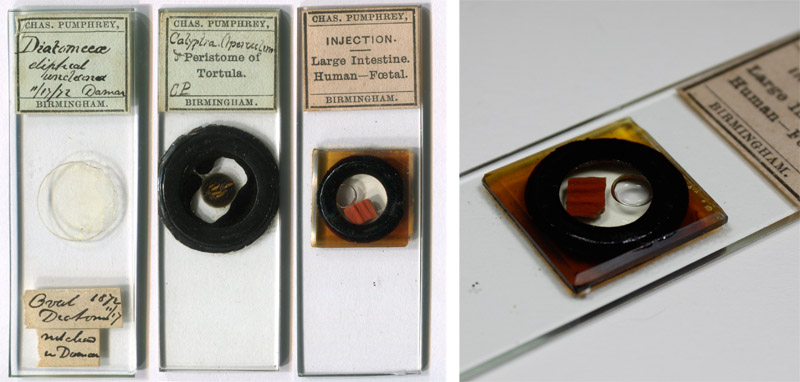
Figure 1.
Examples of Charles Pumphrey’s microscope slides. He
mounted a wide variety of specimen types. Although his custom-printed labels
look professional, there is no evidence to suggest that he sold any of his
preparations. The fluid mount of human fetal intestine used a finely beveled
glass square, approximately 1 mm deep. Other, essentially identical fluid
preparations by Pumphrey are known, suggesting that prepared these himself. It
is possible that he purchased the beveled glasses.
Charles
had close business and social ties with his three brothers, Josiah (1823-1911),
Samuel B. (1826-1912) and Alfred (1830-1913). Josiah was also a member of the
Birmingham Natural History and Microscopical Society. Alfred became a
professional photographer, Josiah produced novel technologies for photography,
and Charles was frequently noted in records for presentations of his
photographs and use of his personal lantern slide projector. Due to their many overlaps, it is often difficult to determine which “Mr. Pumphrey” is being referred to in historical documents. As a further note, there are no known relationships with the noted Victorian photographer William Pumphrey, who lived in York, England.
The four
boys’ father, also named Josiah (ca. 1781-1861) owned a brass foundry. By
mid-century, a rubber factory was added to the family portfolio. Charles and
Samuel inherited the brassworks, while Josiah and Alfred acquired the rubber
factory. Two rubber products proved to be useful for microscopists, as detailed
following. While these were productions of the Josiah/Alfred factory, it is
likely that avid microscopist Charles had a hand in their development.
Their most significant rubber products for microscopy were rings, for use as mounting cells (Figure 2). These were variously described as rubber, vulcanite and ebonite.
Mr. J.E.
Turner wrote to Hardwicke’s
Science-Gossip in 1869, “I have
lately had a supply of Vulcanite Cells from Messrs. Pumphrey,
of Birmingham, and I can safely say they are the best cells that I have
used for mounting objects, dry or in fluid, being far superior to tin or glass
cells, as in change of temperature there is no give in glass or tin, and the
cement cracks; but here we have a substance in every way suited to the wants of
the Microscopist, as the cells can be had in various sizes, as slides 3x1,
perforated with any sized holes, and also as discs to mount opaque objects on,
or to act as a stop to the Lieburkuhn. I have until lately used cells made of
the vulcanized rubber, but these had some disadvantages which are overcome by
The Vulcanite Cells. I find, in cementing them to the glass slide, a scratch
with a fine file on the polished surface causes the marine glue to hold very
firm, and also the top side when cementing down the glass cover; they can also
be ground down to any thickness required by reducing them with a file first,
and finishing off on a flat surface to obtain the cell perfectly level to
receive the glass cover.”
Henry Pocklington (1842-1913), a noted microscopist and writer on the subject,
wrote to The English Mechanic and World of Science, in 1870, “Petals of flowers are rarely capable of presence if their colour is not sufficiently persistent. Those of pelargonium petals may be stripped off, on a glass slip; and mounted in Balsam-potass with them. Thick objects require a cell, which may be glass, wood, vulcanite, or of almost anything. For dry objects cells cut from thick card answer the job
admirably. A common gunwad punch serves to cut them out. I have of late used Pumphrey’s vulcanite cells for all purposes; they are cheap and efficient. Wings of insects rarely require any medium. Wings of Lepidoptera should be mounted dry; ‘opaques’ of Diptera, Neuroptera, and Hymenoptera are also dry‘transparents’.”
Also that
year, R.H. Moore wrote to Hardwicke’s
Science-Gossip, “Your correspondent
has omitted to notice the Vulcanite Cells which are
now used by many microscopists in preference to any other form of cell. They
are fastened to the slide by marine glue, and are perfectly free from leakage.
They can be obtained of any thickness from Mr. S.A. Pumphrey (sic), 21, Paradise-street, Birmingham,
who sends 100 assorted to any address for thirteen stamps.” This letter,
and that of Mr. Turner, sound suspiciously like they were solicited by the
Pumphreys, taking advantage of the popular magazine’s policy of free
publication for letters of advice, etc. Many other businesses finagled free
advertising in such a manner.
Nonetheless,
Pumphrey’s vulcanite cells made a strong, lasting impression among slide
makers. The highly esteemed professional mounter Frederick Enock stated that he
used only those cells. He also developed an improvement, described in this 1881
letter to The Northern Microscopist,
“I have had much bitter experience with
preparations mounted in glycerine, which suffer injury from clumsiness in
handling, more than the fault of expansion; for after a preparation has been
mounted two or three years, the cement becomes very hard, and if injured by a
fall, or knock against the microscope, starts a leak. The number of
preparations ruined by my customers in this and other ways, prompted me to find
a remedy, or to lessen the chance of injury. I have now devised the metal caps,
which so far have stood the heavy thumps of the Post-office men, and all the
clumsy treatment which many give them. The caps are
made to fit Pumphrey's vulcanite cells, as they are
the only cell to be depended upon for size and shape. I never use any other. My
plan of using these caps is as follows: After having fixed the cover properly
and without leakage, I wash the preparation under the tap until all traces of
glycerine are removed, then run a good thick ring of any kind of cement round
the edge of the cover and cell, finally dropping on the cap, when the mount
should be placed aside for a week, so that the cement or varnish may properly
set. I use these caps for all deep cells, as they prevent the cover from being
pushed off, and am having some made half the depth of those sent, for shallow
cells.” Enock then painted over the metal caps, leaving a uniform smooth
black appearance. Pumphrey’s rubber cells are visible from the underside of many of
Enock’s deep mounts, and his metal caps may be visible on slides in which the
black paint is chipped or worn (Figure 3).
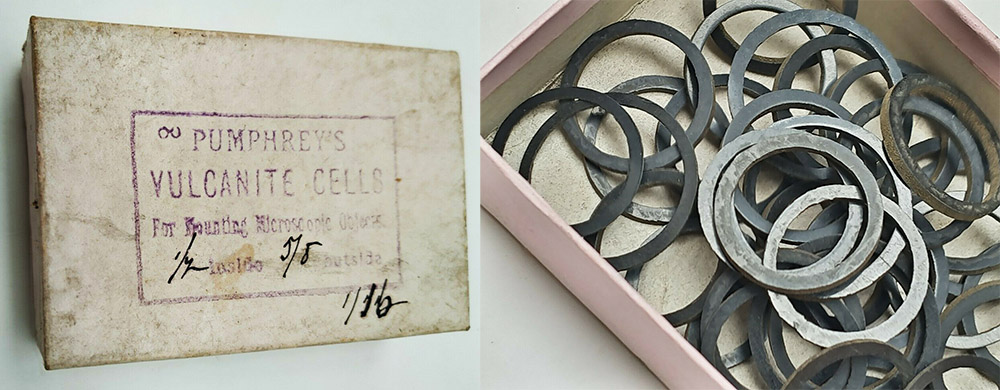
Figure 2.
A box of Charles Pumphrey's "Vulcanite Cells" for use in slide-making. Adapted for nonprofit, educational purposes from an internet auction site.
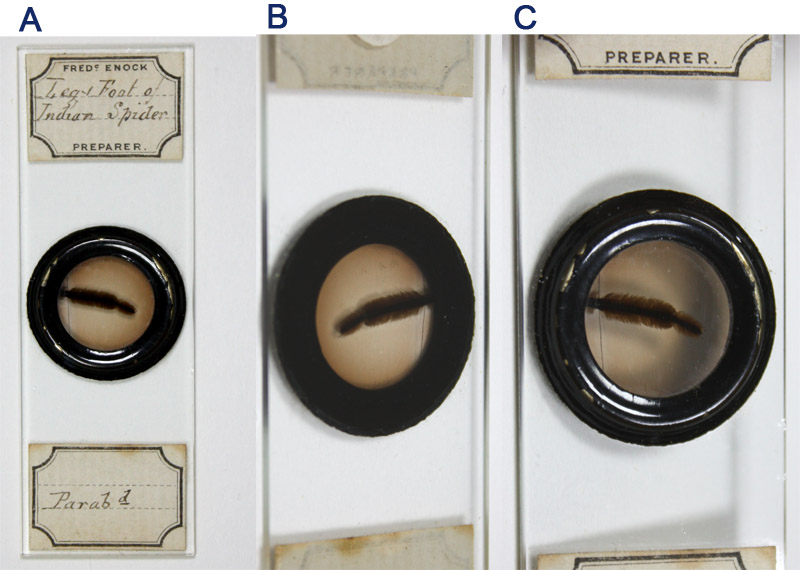
Figure 3.
(A) “Leg
and foot of Indian spider”, by Frederick Enock.
(B) Rear view, showing a Pumphrey’s vulcanite cell. The black
rubber can be difficult to discern from the black paint.
(C) The metal cap used by Enock to protect the ring from being
dislodged is visible where paint has been worn away. The metal appears to be brass.
The
Pumphreys’ second aid to microscopists was an improved wedge for the “zoophyte
trough” (Figure 4). W.P. Marshall, a member of the Birmingham Natural History and Microscopical Society, wrote to Hardwicke’s
Science-Gossip in 1867:
“In the ordinary zoophyte trough used for
examining under the microscope animal or vegetable objects in water in a free,
unconfined condition, the position of the inclined glass plate is regulated by
an ivory wedge in front, supported by a whalebone spring at the back inside the
trough; but this construction has the objection that the spring is liable to be
upset sideways by an accidental touch of the hand, or by catching the stage
bracket of the microscope, causing the object in view at the time to be
suddenly washed out of the field and perhaps lost altogether, to the
disappointment of the observer.
For the purpose of removing this objection, I have
devised, in conjunction with Mr. Pumphrey, a double clip that takes the place
of the wedge and spring, and is found very satisfactory and convenient, and
quite free from risk of disturbance accidentally. This clip is shown full size
in the accompanying drawing, and is made of a piece of ebonite about one-eighth
of an inch thick, having two long cuts upwards from the bottom end, inclined to
one another so as to leave a wedge-shaped piece between them, corresponding to
the ordinary wedge for regulating the position of the inclined glass plate;
whilst the front and back portions act as spring clips, holding the front plate
of the trough and the inclined plate, the two cuts in the clip being made narrower
at the bottom end than the thickness of the glass plates, so as to hold them by
a slight spring pressure, as shown in the detached view of the clip.
By sliding this clip up or down, the width of the
space between the plates that contains the objects under examination, is
regulated in the same manner as by the ordinary wedge; and the clip at the same
time holds the inclined plate securely in each position, without any risk of
being displaced or moved unintentionally, as the clip is entirely free from the
back of the trough, and keeps clear of the stage bracket in all positions
whilst the trough is being moved upon the microscope stage.
The narrowness of this clip is also an advantage, as
the ordinary wide wedge occupies an inconvenient amount of the field of view.
The inclined glass plate, which is usually made as
high as the back of the trough, is cut down in this case to the same height as
the front of the trough, as this is found to be a sufficient height, and allows
the clip to be shorter.
A specimen of these clips is enclosed herewith, and
they are now made by Mr. Pumphrey, Paradise Street, Birmingham, from whom they
can be obtained. In the drawing the larger of the two sizes of zoophyte trough
in ordinary use is shown, but the same clips suit also the smaller size of
trough, and in that case the original height of the inclined glass plate is not
altered.”
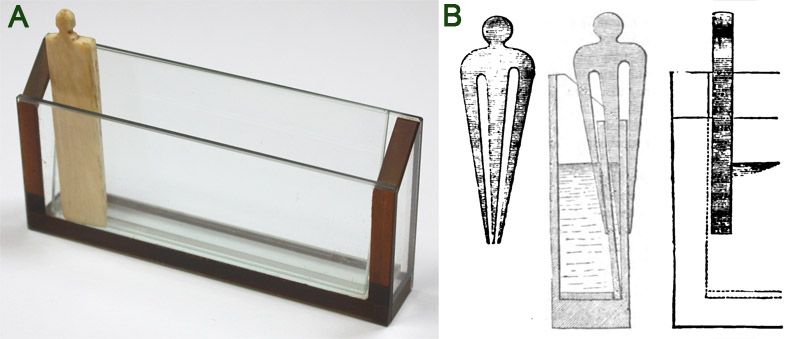
Figure 4.
(A) A Victorian-era zoophyte trough. The glass trough
measures about 3 inches wide. A glass slip fits loosely inside the trough. A
spring, which is absent from this example, would press the glass slip against
the front of the trough, while an ivory wedge would hold the slip slightly away
from the trough front. Thus, microscopic objects in a water sample could be
compressed into a thin area for viewing under the microscope.
(B) Marshall and Pumphrey’s 1867
improved wedge, which was a rubber clip that held both the trough’s front and
the moveable glass slip, eliminated the need for a rear spring.”
Charles
Pumphrey was born June 19, in Worcester, England. During 1823-24, the family
moved to Birmingham, Warwickshire. The 1841 census shows the Pumphreys living
on New Town Row in the St. George parish. Josiah was recorded as being a “brass founder”, as was also 21 year-old
Charles. At some point during the following 7 years, Charles became a partner
in the business with his father. Josiah was awarded a patent in 1847 “for certain improvements in machinery to be
employed in the manufacture of wire hooks and eyes”. Production of hooks
and eyes was the major product of the Pumphreys’ brassworks through the
remainder of the century, although they were also noted as producers of brass
nails in 1848.
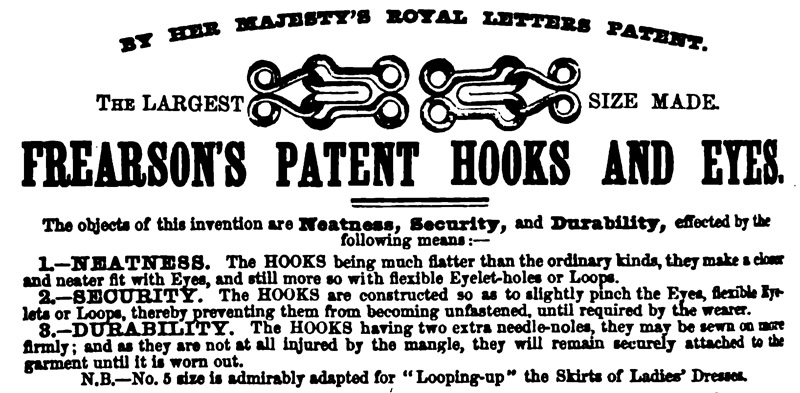
Figure 5.
An 1861 advertisement from another Birmingham
brassworks, shown to clarify the meaning of “hooks and eyes”. I have not
located any advertisements from the Pumphrey businesses. Hooks and eyes were
the primary means for closing women’s’ dresses and other garments, filling the
role occupied today by the zipper. Brass was preferred for this, as it is strong
yet does not rust.
The
Pumphrey brass business evidently fell on hard times in the late 1840s. In
1848, “Pumphrey, J. and C. brass founders and nail manufacturers, Birmingham” was assigned for
benefit of creditors. This appears to have led to reorganization of the
business. The 1851 census recorded Josiah as being a “commercial clerk”. Charles still lived with his parents and most of
his siblings, and was listed as “hook
& eye maker, master, (employs) 17 persons”. On June 30, 1852, Charles
Pumphrey married Emma Palmer.
By 1861,
the family business had diversified to also include rubber manufacturing, with
two brothers operating the brass foundry, and the other two, the rubber
business. An 1861 directory of Birmingham listed “Pumphrey, Charles and Samuel B., manufacturers of hooks and eyes, &c, 40 1/2,
Mount street” and “Pumphrey, Josiah and Alfred, gutta
percha and India rubber manufacturers, and
importers of overshoes, &c., 21, Paradise street, and at 42 1/2, Edmund
street”. In addition, Alfred was operating a photography business from his
home. Father Josiah died in May, 1861, leaving an estate of less than £300.
Presumably, his boys, who all appear to have had successful businesses,
received their father’s wealth before he died.
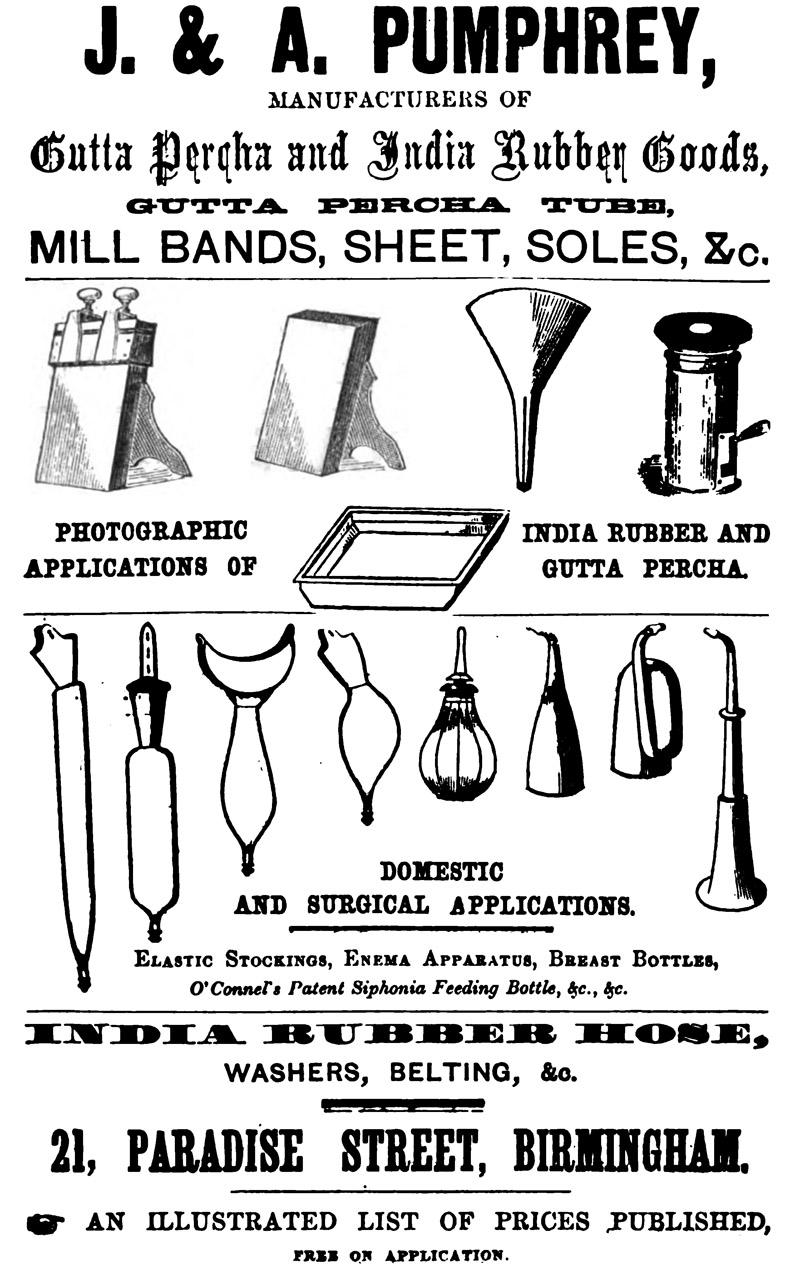
Figure 6.
An 1861 advertisement for Josiah and Alfred
Pumphrey’s rubber company. Their foundry supplied the vulcanite microscope
cells and zoophyte trough clips illustrated in Figures 1-3, above. From the
Corporation General and Trades Directory of Birmingham.
In 1867, Charles
and Samuel also began a rubber manufactory, which Samuel eventually took it over
completely in 1877. As later described in the Illustrated Guide to the Cork International Exhibition of 1883, “The Ladywood Works were founded in 1867 by
Mr. S.B. Pumphrey, for
the production of Rubber goods suited for machinery and the general use of
manufacturers. A year later the Company was formed, and a rapidly progressive
business commenced. The articles made by the Company include driving belts for
machinery, engine and air-pump valves, steam washers, water hose, gas tubes,
bicycle tyres and pedal rubbers, etc.”
Another
business developed during the mid-1860s. “Pumphrey Brothers” sold lantern
projectors, lantern slides and assorted other photography and projection
apparatus and supplies. A later advertisement from Alfred indicated that he was
part of the Pumphrey Brothers. Charles had a strong interest in photography, frequently
presented slide shows of his own photographs with his own projector, so Charles
may have been another partner in that venture. The business ended by 1876, as
advertisements from Alfred that year described him as “late Pumphrey Brothers”.
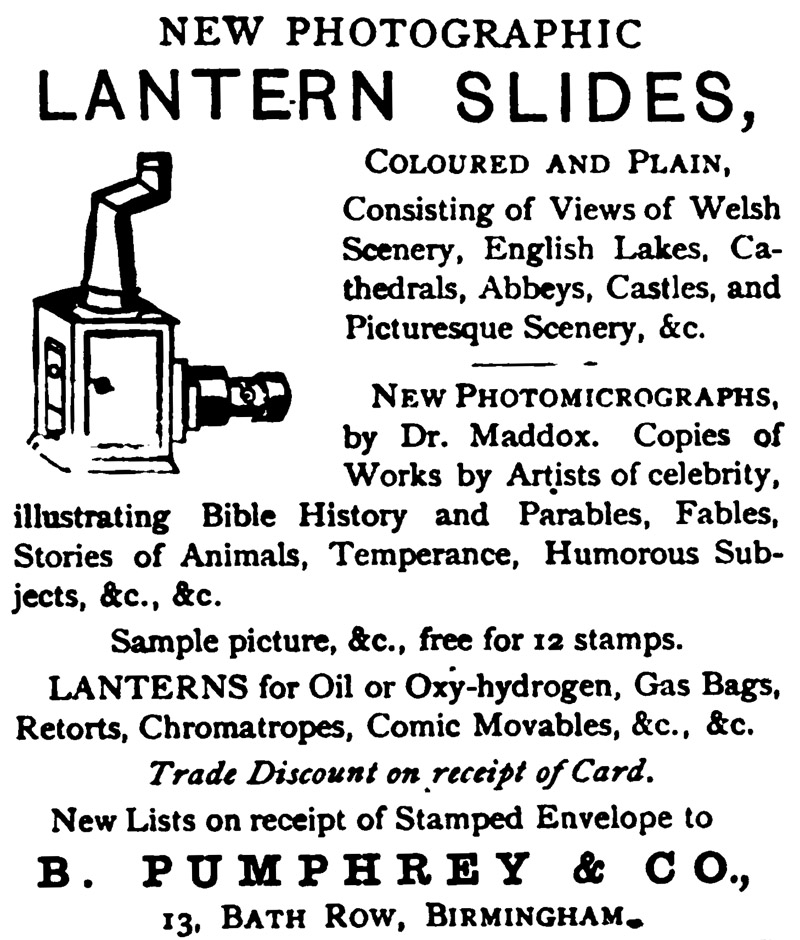
Figure 7.
An 1869 advertisement from the Pumphrey Brothers
(“B. Pumphrey”). Charles may have been a partner in this business. Among their
wares, the Pumphreys sold the celebrated photomicrographs of Richard Maddox.
The
rubber-making partnership of Josiah and Alfred was dissolved in 1873, “Camp-hill Works, Emily-street, India-rubber manufacturers. Josiah Pumphrey, Alfred Pumphrey. Debts received and paid by
Josiah Pumphrey, who will in future carry on the
business. 3rd June 1873”. Alfred then worked full time in photography.
Charles
and Samuel’s partnerships were dissolved in 1877, with Charles taking the
brassworks, and Samuel the rubber business, “Notice is hereby given, that the Partnership heretofore subsisting
between us the undersigned, Charles Pumphrey and Samuel Baker Pumphrey, carrying on business at 89, 90, and 91,
Ryland-street North, Birmingham, in the county of Warwick, under the style or
firm of C. and S.B. Pumphrey, as Hook and Eye Manufacturers, has this day been
dissolved, by mutual consent; and notice is given, that all debts due to and
owing by the said late partnership will be respectively received and paid by
the said Charles Pumphrey, by whom the said business will in future be carried
on. Dated the 29th day of March, 1877. Charles Pumphrey, Saml. B.
Pumphrey”, and “Notice is hereby
given, that the partnership heretofore subsisting between us the undersigned,
Charles Pumphrey, Samuel Baker Pumphrey, and Samuel Price, carrying on business
at 89, 90, and 91, Ryland-street North, Birmingham, in the county of Warwick,
under the style or firm of the Midland India Rubber Company, has this day been
dissolved, by mutual consent, so far as regards the said Charles Pumphrey; and
notice is given, that all debts due to and owing by the said late partnership
will be respectively received and paid by the said Samuel Baker Pumphrey and
Samuel Price, by whom the said business will in future be carried on under the
same style as heretofore. Dated the 29th day of March, 1877, Charles
Pumphrey, Saml. B. Pumphrey, Samuel Price”,
Charles’
wife, Emma, died May 2, 1881. Her obituary in The British Friend indicated that the Pumphreys were Quakers.
Charles remarried on April 1, 1884, to Marion deCastley. Marion died October
24, 1898. Charles married a third time, in mid-1900, to the much-younger Alice
Gertrude Rogers. The 1901 census recorded the household at 5 Park Road, King’s
Norton as containing retired 81 year-old Charles, 47 year-old Alice, Charles’
43 year-old daughter Laura, and two servants.
Charles
died on September 17, 1901. Alice received both Charles’ and Marion’s estates,
valued at just over £15000. The India Rubber
and Gutta Percha and Electrical Trades Journal reported, “The death occurred at his residence,
Castlewood, Park Road, Moseley .. of Mr. Charles Pumphrey, a
very old citizen of Birmingham, and one who was
highly respected for his quiet, unostentatious work in the cause of social
reform. The deceased carried on business in partnership with his brother, Mr.
Samuel Pumphrey, as a hook and eye manufacturer, at
Regent Works, Herbert Road, Small Heath. He was a man of considerable
mechanical knowledge and skill, and was the inventor of a labour-saving machine
which proved of great importance to the industry. For a considerable period he
was associated with his brothers in the rubber trade, their business in Ryland Street being taken over some time since by the
Midland Rubber Company.”
Resources
Birmingham Commercial List (1874) Dissolution of the partnership of J. and A. Pumphrey, Estell and Co.,
London, page 11
Bracegirdle,
Brian (1998) Microscopical Mounts and
Mounters, Quekett Microscopical Club, London, pages 77 and 164, and plate
30, slides J and K
The British Friend (1881) “Deaths .. At Southfield, King’s Norton, near
Birmingham, Emma, wife of Charles Pumphrey, in her 62nd year”, Vol. 39,
page 5
The British Friend (1884) “Marriages .. At St. Philips, Birmingham,
Charles Pumphrey, of King’s Norton, to Marion de Castley. No cards”, Vol.
42, page 89
Corporation General and Trade Directory of Birmingham (1861)
William Cornish, Birmingham, pages 272, 466, 471 650 and 666, and advertising
section
England
census, birth, marriage and death records, accessed through ancestry.co.uk
Harrison,
William J. (1890) “Photography can
admirably record every twig and leaf. It is certain that good photographs of
plants, especially if taken while growing in their native haunts, would help to
vivify the dry leaves of herbaria, and they would be much valued by those who
study and teach botany. I have seen some exquisite work in this direction done
by one of our members, Mr. Charles Pumphrey”, Notes upon a
Proposed Photographic Survey of Warwickshire, Birmingham Photographic
Society, Birmingham, page 16
Hartnell,
H.C. (1883) Illustrated Guide to the Cork
International Exhibition, Guy Brothers, Cork, page 126
The India Rubber and Gutta Percha and Electrical Trades
Journal (1901) Obituary of Charles Pumphrey, Vol. 22, page 261
Law Times (1848) “Assignments. For the Benefit
of Creditors .. July 28. Pumphrey, J. and C. brass founders and nail
manufacturers, Birmingham”, Vol. 11, page 407
London Gazette (1877) Dissolution of the
partnerships between Charles and Samuel Pumphrey, April 20, page 2540
Marshall,
W.P. (1867) Clip for zoophyte trough, Hardwicke’s
Science-Gossip, Vol. 3, page 105
The Midland Naturalist (1889) “Birmingham Natural History and Microscopical
Society – General Meeting Jan. 29th .. Mr. C. Pumphrey and Mr. C. J. Watson exhibited by the aid of
the oxyhydrogen lantern a large number of photographic views of objects and
places of interest in Switzerland, Italy, the Channel Islands, Weymouth, Bath,
and of the recent beautiful hoar frost on leaves and trees in this district,
which were much appreciated by the meeting, and a hearty vote of thanks was
passed to them”, Vol. 12, page 71
The Midland Naturalist (1890) “Birmingham Natural History and Microscopical
Society – Geological Section, March 18th, A paper on Norway and the North Cape
was read by Mr. W. P. Marshall, M.I.C.E., and illustrated by the oxy-hydrogen
lantern by Mr. Charles Pumphrey. There was a very
large attendance, the accommodation of the Examination Hall, Mason College,
being taxed to the uttermost. A hearty vote of thanks was given to Messrs.
Marshall and Pumphrey”, Vol. 13, page 94
Moore,
R.H. (1870) Vulcanite cells, Hardwicke’s Science-Gossip, Vol. 6, page 20
Perry & Co.’s Monthly Illustrated Price Currant (1876) Advertisement from Alfred Pumphrey, Dec. 5, page 44
Pharmaceutical Journal (1875) “Soirée of the Midland Counties Chemists’
Association .. was held in the Town Hall on Thursday evening, Feb. 4th, and was
attended by nearly four hundred persons .. At half-past
eight o'clock the soirée opened with a
lecture by Mr. Josiah Pumphrey, who used limelight illustrations. Dancing
commenced at about halfpast nine”, Vol. 5, page 668
Pocklington, Henry (writing as "H.P.") (1870) Mounting microscopic objects, English Mechanic and World of Science, Vol. 11, page 476
Pritchard, Andrew (1847) “6169. J Pumphrey, Birmingham, brass-founder, for certain improvements in machinery to be employed in the manufacture of wire hooks and eyes. Nov. 2”, English Patents, Whittaker & Co., London, page 405
The Photographic News (1888) “Birmingham Photographic Society .. Charles
Pumphrey .. read his paper on Stereoscopic Pictures from Film Negatives, and
exhibited a number of the same in the stereoscope taken by him on films in
Switzerland. His explanation and description of the process proved of great
interest to the members present. In the discussion which followed, C Pumphrey
said the great bar to taking stereoscopic pictures with amateurs was the
extreme care and exact manipulation required”, Vol. 32, page 350
Post Office Directory of Birmingham (1879)
pages 131, 189, 394, 524 and 527
Probate of
Josiah Pumphrey (1861) “The will with a
codicil of Josiah Pumphrey formerly of Lee-crescent Birmingham but late of 4
Lodge-road All Saints Birmingham in the County or Warwick deceased who died 6
May 1861 at Lodge-road aforesaid was proved at Birmingham by the affirmation of
Rebecca Pumphrey of 4 Lodge-road aforesaid Widow the Relict and the sole
Executrix. Probate being granted under certain Limitations. Effects under £300”,
accessed through ancestry.co.uk
Probate of
Marion Pumphrey (1898) “Pumphrey Marion
of 5 Park-road Moseley Worcestershire (wife of Charles Pumphrey) died 24
October 1898 at 22 Newhall-street Birmingham Administration Worcester 2 May to
Alice Gertrude Pumphrey widow Effects £1150”, accessed through
ancestry.co.uk
Probate of
Charles Pumphrey (1901) “Pumphrey Charles
of 5 Park-road Moseley Worcestershire gentleman died 17 September 1901 Probate
Worcester 10 January to Alice Gertrude Pumphrey widow and Laura Margaret
Pumphrey spinster Effects £14300 18s 5d”, accessed through ancestry.co.uk
Report of the British Association for the Advancement
of Science (1889) Life Members: 1841,
Pumphrey, Charles
Report
of the Microscopical Section of the Birmingham Natural History Society (1869) “The
objects exhibited during the year, not have been so numerous as formerly, yet
unusually rare, exciting much interest, being from personal capture.. Mr. Charles Pumphrey, Stephanoceros Eichornii, marine Polyzoa
of Genera Alcyonidium and Flustra. Two crustacea captured at Watchett,
Phoxichilidium olivaceum and Pycnogonum littorale, also a collection of palates
of Mollusca”, page 15
Scientific Opinion (1870) “Birmingham Natural History and Microscopical Society,
at the meeting held February 8th, … The following are some of the specimens
exhibited at the meetings … By Mr. C. Pumphrey, some
singular cylindrical bodies from Bulimusacuttus, and stellate hairs of Aralia
papyriera (the Chinese rice-paper plant)”, page 253
Scientific Opinion (1870) “Tuesday, (June) 14th,
Birmingham Natural History and Microscopical Society, 7.30 p.m. ‘On the
Preparation and Mounting of Palates of Mollusca’, by C. Pumphrey”, page 516
Turner,
J.E. (1869) Vulcanite cells, Hardwicke’s
Science-Gossip, Vol. 5, page 139






